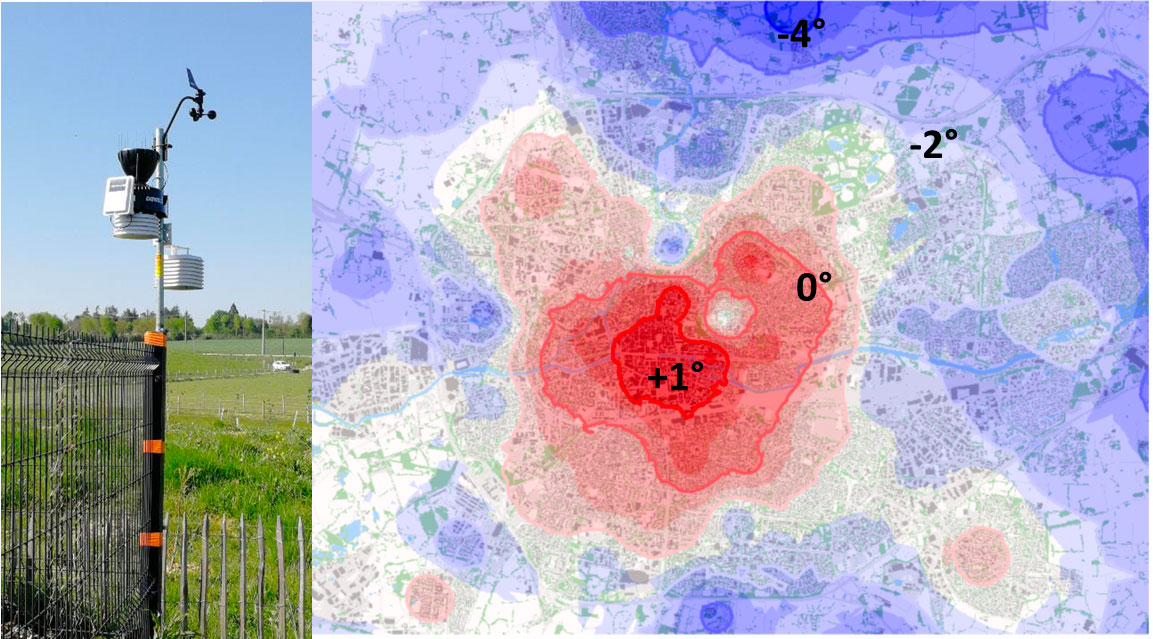ALTELYS
Monitoring heat islands using connected sensors and multi-source satellite data
Overview
The aim of the ALTELYS project is to develop a tool to support the territorial and energy transition of urban buildings by mapping urban heat islands (UHIs) in real time. In this way, ALTELYS will lead to better territorial management and strengthen the resilience of territories in the face of the climate challenges of today and tomorrow.
In addition, through its innovative methodology, the tool gives an important place to local citizens by allowing the collection of participatory data to be as close as possible to local realities. The tool developed will be available to a wide range of users, from land managers to local residents, not forgetting those involved in research: the tool will enable data to be viewed and accessed differently according to an established typology of users.
Methodology
ALTELYS proposes a bottom-up approach to mapping UHI. To do this, the project first analyses the territorial characteristics of UHI in detail using in-situ data, then generalizes them to larger ensembles and to the fine scale of territories using multi-source satellite data. This innovative approach, based on a network of sensors located within the urban matrix and supplemented by satellite data, enables the creation of reference libraries linked to buildings on the one hand, and to seasonal weather patterns on the other.
What's more, by taking into account quantitative and qualitative metrics for the inside and outside of buildings (indoor/outdoor), we can significantly improve our knowledge (climatic and energy) of buildings in the immediate environment.
The work carried out by the LETG-Rennes laboratory, in particular the RUN project, its LoRaWAN-connected sensors and its dedicated Rennes Urban Network platform, is the entry point for ALTELYS. In Brazil, the project's international application area, data from NetAtmo connected sensors will be used.
Application site(s)
- Rennes, France
- Presidente Prudente, Brazil
Data
The data used is by nature multiple and heterogeneous in terms of its types and sources. It is made up of satellite images, vector data and tabular data.
Satellite
Satellite imagery will be used to characterize surfaces (buildings, vegetation, phenology) at high resolution, as well as their thermal behavior (infrared), and then to generalize climate information (UHI) to the whole of the country. The developments made will be compatible with the next TRISHNA mission.
- Optical data (visible and near infrared):
- Landsat 8 and 9
- Aster
- Sentinel-2: land use
- Sentinel-3: Surface temperatures
- Pleiades: land use, DSM, DTM, DHM
- Infrared (thermal) data:
- Landsat 8 and 9
- Aster
- Ecostress (subject to availability/compatibility)
- Some of this data will be taken (subject to compatibility) from previous SCO projects, in particular THERMOCITY, SAT4BDNB.
Other
- IoT sensor network (indoor / outdoor):
- LoRaWan (sensors from the Rennes Urban Network, France)
- NetAtmo (citizen sensors to be deployed in Brazil).
- Matrix data:
- IGN HD LIDAR
- Pleiades DSM
- Copernicus "large scale" (temperature, relative humidity)
- Surface temperature by month / department
- Vector data :
- IGN Database topo /parcel - OpenStreetMap
- BDNB (National Building Database)
- BDD DPE (Database of Energy Performance Diagnostics)
Consortium
The project brings together a wide range of players already involved in joint projects, for the benefit of local players and the general public.
- Academic players :
- LETG Joint Research Unit, CNRS University of Rennes 2
- University of the State of São Paulo (UNESP), Presidente Prudente campus, Brazil. UNESP and LETG-Rennes have been working together for several years on monitoring the UHI, notably as part of the bilateral CICLAMEN project.
- Private company: Alkante. Brittany-based software engineering company based in Rennes, specializing in space applications since its creation in 2003. The Alkante group has 55 employees (10% of whom are doctors/researchers) who implement and develop applications and operate (host, maintain, outsource) open-source data infrastructures.
- End users
- Rennes Metropolitan Area
- Municipality of Saint-Sulpice-La-Forêt
- Rennes Local Energy and Climate Agency (ALEC)
- Municipality of Presidente Prudente
- Citizens (in France and Brazil)
Results – Final product(s)
Web platform integrating contextualization elements linked to CIPs, real-time monitoring (mapping) and dashboards.
References
 |
ALTELYS on GEO Knowledge Hub, a long lasting digital repository created by the Group on Earth Observations: https://doi.org/10.60566/w4hyd-x8w93 |
- DUBREUIL V., FOISSARD X., NABUCET J., THOMAS A., QUENOL H., 2020 : Fréquence et intensité des îlots de chaleur à rennes : bilan de 16 années d’observations (2004-2019). Climatologie, 17 (6), p.1-17.
- DUBREUIL V., BRABANT C., DELAUNAY G., NABUCET J., QUENOL H., CLAIN F., LEPRINCE F., DREANO J., GEORGET L., 2022 : Rennes, une ville climato-intelligente ? L’IoT au service du suivi des îlots de chaleur. Editions Techniques de l’Ingénieur.
- AMORIM M.C.C.T., DUBREUIL V., AMORIM A., 2021 : Day and night surface and atmospheric heat islands in a continental and temperate tropical environment. Urban Climate. 38, 100918.
- AMORIM M.C.C.T., DUBREUIL V., 2017 : Intensity of Urban Heat Islands in Tropical and Temperate Climates. Climate, 5(4), 91.
Related projects
- RUN Rennes Urban Network website
- CAPES-COFECUB Sh 941/19 CiClAMEn (2019-2023): Cities, Climate And vegetation: Modeling and Environmental public policies. (UNESP, Presidente Prudente, Brésil ; LETG-Rennes).
- COST-FAIRNEss, UE-CA20108 - FAIR NEtwork of micrometeorological measurements.
- SCO projects:
Project news
- 19/12/2024: Presentation of the ALTELYS project and its progress at the 15th SCO France Quarterly Meeting "Making the most of high-resolution imaging in the city: flooding and heat islands"
- 24/08/2024: ALTELYS, combating urban heat islands: installation of connected sensors in Brazil






